Feast June 22 Name Paulinus Nola | Role Poet | |
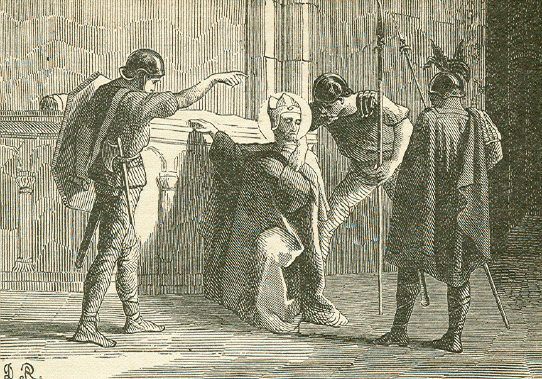 | ||
Books Sancti Pontii Meropii Pavlini Nolani Carmina | ||
Saint paulinus of nola bishop confessor
Paulinus of Nola (Italian: Paolino di Nola; c. 354 – June 22, AD 431), born Pontius Meropius Anicius Paulinus, was a Roman poet, writer, and senator who attained the ranks of suffect consul (c. 377) and governor of Campania (c. 380–1) but—following the assassination of the emperor Gratian and under the influence of his Spanish wife Therasia—abandoned his career, was baptized as a Christian, and (after Therasia's death) became bishop of Nola in Campania. While there, he wrote poems in honor of his predecessor St Felix and corresponded with other Christian leaders throughout the empire. He is traditionally credited with the introduction of bells to Christian worship and helped resolve the disputed election of Pope Boniface I.
Contents
- Saint paulinus of nola bishop confessor
- Communion of saints paulinus of nola john fisher thomas more
- Life
- Influence
- Legend
- Relics
- Modern devotion to St Paulinus
- References
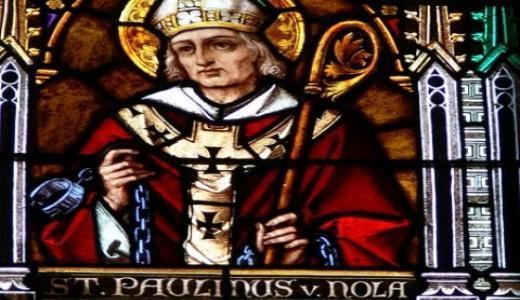
His renunciation of his wealth and station in favor of an ascetic and philanthropic life was held up as an example by many of his contemporaries—including SS Augustine, Jerome, Martin, and Ambrose—and he was subsequently venerated as a saint. His relics became a focus of pilgrimage, but were removed from Nola between the 11th and 20th centuries. His feast day is observed on June 22 in both the Roman Catholic and Eastern Orthodox Churches. In Nola, the entire week around his feast day is celebrated as the Festival of the Lilies.
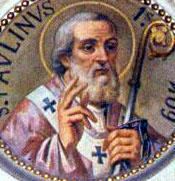
Communion of saints paulinus of nola john fisher thomas more
Life
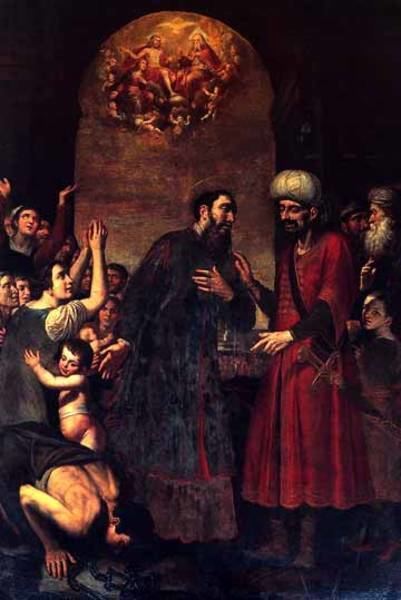
Pontius Meropius Paulinus was born c. 352 at Bordeaux, in southwestern France. He was from a notable senatorial family with estates in the Aquitaine province of France, northern Spain, and southern Italy. Paulinus was a kinsman of Melania the Elder. He was educated in Bordeaux, where his teacher, the poet Ausonius, also became his friend. At some time during his boyhood he made a visit to the shrine of St Felix at Nola near Naples.
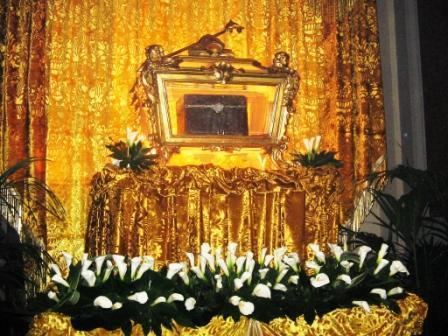
His normal career as a young member of the senatorial class did not last long. In 375, the Emperor Gratian succeeded his father Valentinian. Gratian made Paulinus suffect consul at Rome c. 377, and appointed him governor of the southern Italian province of Campania c. 380. Paulinus noted the Campanians' devotion to Saint Felix of Nola and build a road for pilgrims, as well as a hospice for the poor near the local shrine.
In 383 Gratian was assassinated at Lyon, France, and Paulinus went to Milan to attend the school of Ambrose. Around 384 he returned to Bordeaux. There he married Therasia, a Christian noblewoman from Barcelona. Paulinus was threatened with the charge of having murdered his brother. It is possible that an attempt was made to accuse him in order to confiscate his property. He was baptized by Bishop Delphinus of Bordeaux. He and his wife traveled to Spain about 390. When they lost their only child eight days after birth they decided to withdraw from the world, and live a secluded religious life.
In 393 or 394, after some resistance from Paulinus, he was ordained a presbyter on Christmas day by Lampius, Bishop of Barcelona. (This was similar to what had happened with St. Augustine of Hippo, who had been ordained against his protestations in the year 391 at the behest of a crowd cooperating with Bishop Valerius in the north African city of Hippo Regius.) However, there is some debate as to whether the ordination was canonical, since Paulinus received ordination "at a leap" (per saltum), without receiving minor orders first.
Paulinus refused to remain in Barcelona, and in late spring of 395 he and his wife moved from Spain to Nola in Campania where he remained until his death. Paulinus credited his conversion to St. Felix, who was buried in Nola, and each year would write a poem in honor of the saint. He and Therasia also rebuilt a church commemorating St. Felix. During these years Paulinus engaged in considerable epistolary dialogue with St. Jerome among others about monastic topics. Therasia died some time between 408 and 410, and shortly afterwards Paulinus received episcopal ordination. Around 410, Paulinus was chosen Bishop of Nola, where he served for twenty years. Like a growing number of aristocrats in the late 4th and early 5th centuries who were entering the clergy rather than taking up the more usual administrative careers in the imperial service, Paulinus spent a great deal of his money on his chosen church, city and ritual.
Paulinus died at Nola on June 22, 431. The following year the presbyter Uranus wrote his "On the Death of Paulinus" (De Obitu Paulini), an account of the death and character of the saint.
Influence
As bishop of Nola, Paulinus is traditionally credited with the introduction of the use of bells in church services. One form of medieval handbell was known as the nola and medieval steeple bells were known as campanas from this supposed origin.
Already during his governorship Paulinus had developed a fondness for the 3rd-century martyr, St. Felix of Nola. Felix was a minor saint of local importance and patronage whose tomb had been built within the local necropolis at Cimitile, just outside the town of Nola. As governor, Paulinus had widened the road to Cimitile and built a residence for travelers; it was at this site that Paulinus and Therasia took up residence. Nearby were a number of small chapels and at least one old basilica. Paulinus rebuilt the complex, constructing a brand new basilica to Felix and gathering to him a small monastic community. Paulinus wrote an annual hymn (natalicium) in honor of St. Felix for the feast day when processions of pilgrims were at their peak. In these hymns we can understand the personal relationship Paulinus felt between himself and Felix, his advocate in heaven. His poetry shares with much of the work of the early 5th century an ornateness of style that classicists of the 18th and 19th centuries found cloying and dismissed as decadent, though Paulinus' poems were highly regarded at the time and used as educational models.
Many of Paulinus's letters to his contemporaries, including Ausonius and Sulpicius Severus in southern Gaul, Victricius of Rouen in northern Gaul, and Augustine in Africa, are preserved.
Paulinus may have been indirectly responsible for Augustine's Confessions: Paulinus wrote to Alypius, Bishop of Thagaste and a close friend of St. Augustine, asking about his conversion and taking up of the ascetic life. Alypius's autobiographical response does not survive; St. Augustine's ostensible answer to that query is the "Confessions."
We know about his buildings in honor of St. Felix from literary and archaeological evidence, especially from his long letter to Sulpicius Severus describing the arrangement of the building and its decoration. He includes a detailed description of the apse mosaic over the main altar and gives the text for a long inscription he had written to be put on the wall under the image. By explaining how he intended the visitors to understand the image over the altar, Paulinus provided rare insight into the intentions of a patron of art in the later Empire. He explained his project in a Poem dedicated to another great catechist, St Nicetas of Remesiana, as he accompanied him on a visit to his basilicas: "I now want you to contemplate the paintings that unfold in a long series on the walls of the painted porticos.... It seemed to us useful to portray sacred themes in painting throughout the house of Felix, in the hope that when the peasants see the painted figure, these images will awaken interest in their astonished minds."
In later life Paulinus, by then a highly respected church authority, participated in multiple church synods investigating various ecclesiastical controversies of the time, including Pelagianism.
Legend
Gregory the Great recounts a popular story that alleges that when the Vandals raided Campania, a poor widow came to Paulinus for help when her only son had been carried off by the son-in-law of the Vandal king. Having exhausted his resources in ransoming other captives, Paulinus said, "Such as I have I give thee", and went to Africa to exchange places with the widow's son. There Paulinus was accepted in place of the widow's son, and employed as gardener. After a time the king found out that his son-in-law's slave was the great Bishop of Nola. He at once set him free, granting him also the freedom of all the captive townsmen of Nola. According to Pope Benedict XVI, "...the historical truth of this episode is disputed, but the figure of a Bishop with a great heart who knew how to make himself close to his people in the sorrowful trials of the barbarian invasions lives on."
Relics
About 800 Prince Grimoald III of Benevento removed Paulinus's bones as relics.
From the 11th century they rested at the church of Saint Adalbert, now Saint Bartholomew, on the island in the Tiber in Rome. In 1908 Pope Pius X permitted them to be translated to the new cathedral at Nola, where they were reinterred on 15 May 1909.
The bones are now found in the small Sicilian city of Sutera, where they dedicate a feast day, and conduct a procession for the saint at Easter each year.
Modern devotion to St. Paulinus
The people of modern-day Nola and the surrounding regions remain devoted to St. Paulinus. His feast day is celebrated annually in Nola during "La Festa dei Gigli" (the Feast of the Lilies), in which Gigli and several large statues in honor of the saint, placed on towers, are carried upon the shoulders of the faithful around the city. In the United States the descendants of Italian immigrants from Nola and Brusciano continue the tradition in Brooklyn.
